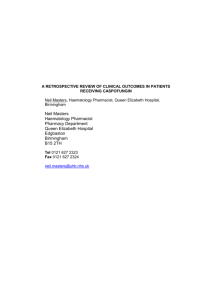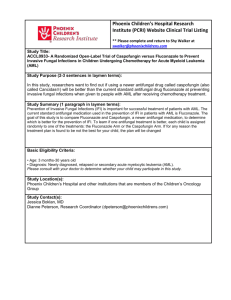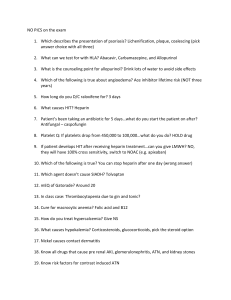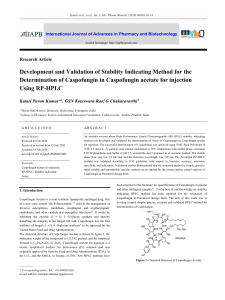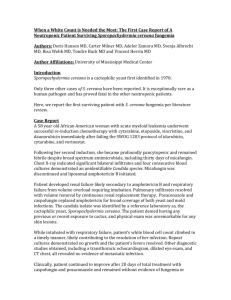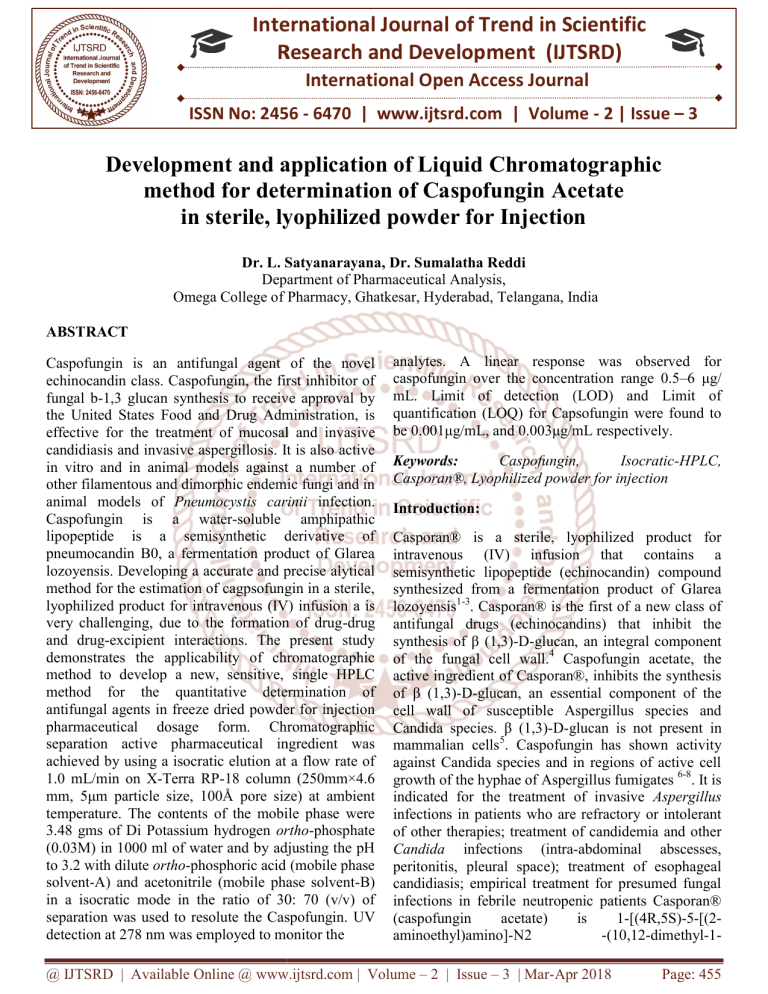
International Journal of Trend in Scientific
Research and Development (IJTSRD)
International Open Access Journal
ISSN No: 2456 - 6470 | www.ijtsrd.com | Volume - 2 | Issue – 3
Development and application of Liquid Chromatographic
method for determination of Caspofungin Acetate
in sterile, lyophilized powder for Injection
Dr. L. Satyanarayana, Dr. Sumalatha Reddi
Department oof Pharmaceutical Analysis,
Omega College off Pharmacy, Ghatkesar, Hyderabad, Telangana,, India
ABSTRACT
Caspofungin is an antifungal agent of the novel
echinocandin class. Caspofungin, the first inhibitor of
fungal b-1,3
1,3 glucan synthesis to receive approval by
the United States Food and Drug Administration, is
effective for the treatment of mucosal and invas
invasive
candidiasis and invasive aspergillosis. It is also active
in vitro and in animal models against a number of
other filamentous and dimorphic endemic fungi and in
animal models of Pneumocystis carinii infection.
Caspofungin is a water-soluble
soluble amphipathic
lipopeptide is a semisynthetic derivative of
pneumocandin B0, a fermentation product of Glarea
lozoyensis. Developing a accurate and precise alytical
method for the estimation of cagpsofungin in a sterile,
lyophilized product for intravenous (IV) infusion a is
very challenging, due to the formation of drug
drug-drug
and drug-excipient
excipient interactions. The present study
demonstrates the applicability of chromatographic
method to develop a new, sensitive, single HPLC
method for the quantitative determination of
antifungal
fungal agents in freeze dried powder for injection
pharmaceutical dosage form. Chromatographic
separation active pharmaceutical ingredient was
achieved by using a isocratic elution at a flow rate of
1.0 mL/min on X-Terra RP-18
18 column (250mm×4.6
mm, 5μm particle
ticle size, 100Å pore size) at ambient
temperature. The contents of the mobile phase were
3.48 gms of Di Potassium hydrogen ortho
ortho-phosphate
(0.03M) in 1000 ml of water and by adjusting the pH
to 3.2 with dilute ortho-phosphoric
phosphoric acid (mobile phase
solvent-A)) and acetonitrile (mobile phase solvent
solvent-B)
in a isocratic mode in the ratio of 30: 70 (v/v) of
separation was used to resolute the Caspofungin. UV
detection at 278 nm was employed to monitor the
analytes. A linear response was observed for
caspofungin over
ver the concentration range 0.5–6
0.5 μg/
mL. Limit of detection (LOD) and Limit of
quantification (LOQ) for Capsofungin were found to
be 0.001μg/mL, and 0.003μg/mL respectively.
Keywords:
Caspofungin,
Isocratic-HPLC,
Isocratic
Casporan®, Lyophilized
yophilized powder for injection
Introduction:
Casporan® is a sterile, lyophilized product for
intravenous (IV) infusion that contains a
semisynthetic lipopeptide (echinocandin) compound
synthesized from a fermentation product of Glarea
lozoyensis1-3. Casporan® is the first of a new class of
antifungal drugs (echinocandins) that inhibit the
synthesis of β (1,3)-D-glucan,
glucan, an integral component
of the fungal cell wall.4 Caspofungin acetate, the
active ingredient of Casporan®, inhibits the synthesis
of β (1,3)-D-glucan,
glucan, an essential
essentia component of the
cell wall of susceptible Aspergillus species and
Candida species. β (1,3)-D-glucan
glucan is not present in
mammalian cells5. Caspofungin has shown activity
against Candida species and in regions of active cell
growth of the hyphae of Aspergillus
Aspergill fumigates 6-8. It is
indicated for the treatment of invasive Aspergillus
infections in patients who are refractory or intolerant
of other therapies; treatment of candidemia and other
Candida infections (intra--abdominal abscesses,
peritonitis, pleural space); treatment of esophageal
candidiasis; empirical treatment for presumed fungal
infections in febrile neutropenic patients Casporan®
(caspofungin
acetate)
is
1-[(4R,5S)-5-[(21
aminoethyl)amino]-N2
N2
-(10,12-dimethyl-1-
@ IJTSRD | Available Online @ www.ijtsrd.com | Volume – 2 | Issue – 3 | Mar-Apr
Apr 2018
Page: 455
International Journal of Trend in Scientific Research and Development (IJTSRD) ISSN: 2456-6470
oxotetradecyl)-4-hydroxy-L-ornithine]-5-[(3R)-3hydroxy-L-ornithine] pneumocandin B0 diacetate
(salt). Casporan® 50 mg also contains: 39 mg
sucrose, 26 mg mannitol, glacial acetic acid, and
sodium hydroxide. Casporan® 70 mg also contains 54
mg sucrose, 36 mg mannitol, glacial acetic acid, and
sodium hydroxide. Caspofungin acetate is a
hygroscopic, white to off-white powder. It is freely
soluble in water and methanol, and slightly soluble in
ethanol. The pH of a saturated aqueous solution of
caspofungin acetate is approximately 6.6. The
empirical formula is C52H88N10O15•2C2H4O2 and the
formula weight is 1213.429-10. Casporan® 50 mg is a
white to off-white powder/cake for infusion in a vial
with a red aluminum band and a plastic cap supplied
as one single-use vial. Casporan® 70 mg is a white to
off-white powder/cake for infusion in a vial with a
yellow/orange aluminum band and a plastic cap.
Figure-1: Chemical structures of Caspofungin
A survey of literature has revealed only one analytical
method for the determination of caspofungin in
biological fluids. These include; high-performance
liquid chromatography (HPLC) 11. On the contrary, to
the best of our knowledge, there is no method
reporting the determination of Caspofungin in
pharmaceutical formulation. In this paper, we report
the simple precise and accurate RP-HPLC method for
the assay of caspofungin acetate for Intravenous (IV)
Infusion in sterile lyophilized powder for injection
dosage form.
The new method is capable of
separating active ingredient present in the Intravenous
(IV) Infusion. Validation of the current method will
be performed according to the requirements of USP
for assay determination which include accuracy,
precision, selectivity, linearity and range.
Experimental:
Chemicals and reagents: Caspofungin was obtained
as kind gift sample from Gland Pharma Ltd,
Hyderabad. Potassium dihydrogen ortho-phosphate,
methanol, acetonitrile and ortho-phosphoric acid were
obtained from Merck, Mumbai, India. All the
solutions were prepared in Milli Q water (Millipore,
USA). Test samples composed of Casporan® 50 mg
lyophilized powder for intravenous administration
vial, Ranbaxy, India contains 50 mg of Caspofungin,
is obtained from local market.
HPLC Instrumentation and Chromatographic
conditions: Quantitative HPLC was performed on the
Waters Alliance 2695 Separations Module is a high
performance liquid chromatographic system with a
quaternary, low-pressure mixing pump and inline
vacuum degassing. Waters Alliance 2695 separation
module (Waters Corporation, Milford, USA)
equipped with 2489 UV/visible detector or 2998 PDA
detector with Empower 2 software was used for the
analysis. Flow rates from 50 uL/ min to 5 mL/min can
be generated for use with 2.1 mm ID columns and
larger. The auto-sampler has a maximum capacity of
120 vials (12x32, 2-mL) with programmable
temperature control from 4 to 40°C. A heated column
compartment provides temperatures from 5 degrees
above ambient to 65°C. The detector is a photodiode
array (model 2996) with a wavelength range of 190800 nm and sensitivity settings from 0.0001-2.0000
absorbance units The HPLC system was equipped
with a column compartment with temperature control
and an on-line degasser. X-Terra RP-C18 Column
(250x4.6 mm i.d; particle size 5 μm) was used for
separation of Caspofungin. The contents of the
mobile phase were 3.48 gms of Di Potassium
hydrogen ortho-phosphate (0.03M) in 1000 ml of
water and by adjusting the pH to 3.2 with dilute
ortho-phosphoric acid (mobile phase solvent-A) and
acetonitrile (mobile phase solvent-B) in a isocratic
mode in the ratio of 30: 70 (v/v) of separation was
used to resolute the Caspofungin. They were filtered
before use through a 0.45 μm membrane filter and
degassed by sonication. The flow was adjusted at 1.0
ml/min flow rate and 20 μL injection load volumes
were maintained. The eluted compounds were
monitored at 278 nm. The column oven temperature
was maintained at 25 ◦C. Data acquisition, analysis,
and reporting were performed by Empower2 (Waters)
chromatography software.
@ IJTSRD | Available Online @ www.ijtsrd.com | Volume – 2 | Issue – 3 | Mar-Apr 2018
Page: 456
International Journal of Trend in Scientific Research and Development (IJTSRD) ISSN: 2456-6470
Preparation of Solutions:
Standard and stock solutions: Standard solution of
the active pharmaceutical ingredient was prepared in
the following manner: Transfer 5 mg of caspofungin
working standard into a 100 ml volumetric flask,
dissolve and dilute with Acetonitrile and water in the
ratio of 50:50 v/v as diluent. 5 ml of the resulting
solution is further diluted up to 50 ml in volumetric
flask with diluents. The resulting solution contains 5
μg/mL of caspofungin as working standard solutions.
The prepared stock solutions were stored at 4 0C and
protected from light.
Specificity: The terms selectivity and specificity are
often used interchangeably. The specificity of the
developed LC method for quantification of active
pharmaceutical ingredient was determined the
presence of excipients present in pharmaceutical
products. In specificity study, interference between
drugs and excipients usually employed in lyophilized
powder for injection was evaluated from the
comparison of spectral purity obtained from the
analysis for the standard solutions and sample
solutions.
Preparation of the Sample solution: Casporan® 50
mg is a white to off-white powder/cake for infusion in
a vial with a red aluminum band and a plastic cap.
Casporan® is a sterile, lyophilized product for
intravenous (IV) infusion that contains a
semisynthetic lipopeptide (echinocandin) compound
synthesized from a fermentation product of Glarea
lozoyensis. Casporan® 50 mg also contains: 39 mg
sucrose, 26 mg mannitol, glacial acetic acid, and
sodium hydroxide. The contents of 5 vials are emptied
and their average weight was calculated. The vial
contents were blended to a homogeneous powder and
a quantity equivalent to 5 mg was weighed and
transferred in to a 100-mL volumetric flask, extracted
in diluent by sonication, and filtered through
Whatman no. 41 filter paper. The filtrate (5 mL) was
quantitatively transferred to a 50-mL volumetric flask,
and solution was diluted to volume with the diluents.
The resulting solution contains 5 μg/mL of
caspofungin as working sample solutions. The
prepared stock solutions were stored at 4 0C and
protected from light.
System suitability: The system suitability was
assessed by six replicate analyses of the drugs at
concentrations of 5 μg/ mL for caspofungin. The
acceptance criterion was ±2% for the RSD for the
peak area and retention times for all four analytes.
The system suitability parameters with respect to
theoretical plates, tailing factor, repeatability and
resolution between peak and peaks of the other three
analytes were defined.
Solutions for validation study:
Calibration and Quality control samples: Calibration
standards (0.5–6 μg/ mL of caspofungin were
prepared from working standard solutions by
appropriate dilution with Acetonitrile and water in the
ratio of 50:50 v/v as diluents. Quality control (QC)
samples for accuracy studies were prepared at three
concentrations of the linearity range (4 μg/ mL, 5 μg/
mL and 6 μg/ mL) for caspofungin were prepared
from the standard solutions.
Method Validation: The developed chromatographic
method was validated for selectivity, linearity,
precision, accuracy, sensitivity, robustness and system
suitability.
Linearity: Linearity of the method was evaluated at
seven equi-spaced concentration levels by diluting the
standard solutions to give solutions over the ranges
10–120% target concentration for main analyte of
interest. The calibration curves were constructed at
seven concentrations between 0.5–6 μg/ mL for
caspofungin. These were injected in triplicate and the
peak areas were inputted into a Microsoft Excel®
spreadsheet program to plot calibration curves. The
linearity was evaluated by linear regression analysis,
which was calculated by the least square regression
method. The peak areas of the analyte to
concentration of analyte were used for plotting the
linearity graph. The linearity data is reported in Table3.
Table-3: Linearity Data for caspofungin
Precision: Precision was evaluated in terms of intraday repeatability and inter-day reproducibility. The
intra-day repeatability was investigated using six
separate sample solutions prepared, as reported above,
from the freshly reconstructed tablet formulations at
100% of the target level. Each solution was injected in
triplicate and the peak areas obtained were used to
calculate means and RSD% values. The inter-day
reproducibility was, by preparing and analyzing in
triplicate sample solutions from the reconstructed
formulations at the same concentration level of intra-
@ IJTSRD | Available Online @ www.ijtsrd.com | Volume – 2 | Issue – 3 | Mar-Apr 2018
Page: 457
International Journal of Trend in Scientific Research and Development (IJTSRD) ISSN: 2456-6470
day repeatability; the means and RSD% values were
calculated from peak areas. (Table-4)
Table-4: Intra-day and inter-day precision data for for
caspofungin
Accuracy: The accuracy of the method was
determined by measuring the recovery of the drug by
the method of standard additions. Quality control
(QC) samples for accuracy studies were prepared at
three concentrations of the linearity range (4 μg/ mL
(80% dilution), 5 μg/ mL (100% dilution) and 6 μg/
mL (120% dilution) for caspofungin were prepared
from the standard solutions. Known amounts of 10 %
dilution of each drug corresponding to 80%, 100%,
and 120% of the target test concentrations (0.5 μg/mL
of caspofungin) were added to a placebo mixture to
determine whether the excipients present in the
formulation led to positive or negative interferences.
Each set of additions was repeated three times at each
level. Extraction sample preparation procedure is
followed and assayed against qualified reference
standard. The accuracy was expressed as the
percentage of the analytes re-covered by the assay.
(Table-5)
Table-5: Accuracy: recovery data for caspofungin
Sensitivity: Limits of detection (LOD) and
quantification (LOQ) were estimated from the signalto-noise ratio. The detection limit was determined as
the lowest concentration level resulting in a peak area
of three times the baseline noise. The limit of
detection was determined, by injecting progressively
low concentrations of analyte of interest. The
quantification limit was determined as the lowest
concentration level that provided a peak area with
signal-to-noise 10.
Robustness: To determine the robustness of the
developed method, experimental conditions were
deliberately changed and the relative standard
deviation for replicate injections of caspofungin and
the USP resolution factor between and the other two
peaks were evaluated. The mobile phase flow rate was
1.0 mL/min. This was changed by ±0.2 units to 0.8
and 1.2 mL/min. The effect of stationary phase was
studied by the use of LC columns from different
batches at 25°C. The effect of buffer pH was studied
at pH 3.0 and 3.4 (± 0.2 units). The chromatographic
variations were evaluated for resolution between and
the other three analytes in a system suitability solution
with respect to retention time RT and % assay of
drugs.
Table-6: Robustness data for caspofungin
Solution stability: To assess the solution stability,
standard and test solutions were kept at 25 ◦C
(laboratory temperature) for 24 h. These solutions
were compared with freshly prepared standard and
test solutions.
RESULTS AND DISCUSSION:
HPLC method development: The API solution of
analyte of interest i,e., caspofugin was prepared in
diluent at a concentration of 50μg/mL and scanned in
UV-Visible spectrometer; and the caspofungin was
found to have UV maxima at around 278 nm. Hence
detection at 278 nm was selected for method
development purpose. Some important parameters,
pH of the mobile phase, concentration of the acid or
buffer solution, percentage and type of the organic
modifier, etc. were tested for a good chromatographic
separation. The main analytical challenge during
development of a new method was obtaining adequate
retention of the polar compound caspofungin. Trials
showed that acidic mobile phase with reverse phase
column gives symmetric and sharp peaks. For this
reason, potassium dihydrogen phosphate buffer with
pH-3.2 was adjusted with o-phosphoric acid was
preferred as acidic buffer solution. Acetonitrile and
buffer n the ratio of 70:30 (v/v) was chosen as the
organic modifier because it dissolves drugs very well.
Mobile phase composition in isocratic mode at a flow
rate of 1.0 mL per minute was observed for a good
resolution. Then method was optimized to separate
the active ingredient by changing to isocratic mode.
The satisfactory chromatographic separation, with
good peak shapes were achieved on X-Terra RP-18C18 (250 × 4.6) mm with 5 μm particles, using the
column temperature as maintained at 35°C and the
detection was monitored at a wavelength of 278 nm.
The injection volume was 20 μL. Acetonitrile and
water in the ratio of 50:50 v/v) were used as diluent.
In the optimized isocratic conditions, caspofungin was
well separated with a resolution (Rs) of greater than 2
and the typical retention time of about 3.35 minutes,
the typical chromatogram of System suitability shown
in Figure 2.
Method validation:
The developed method was validated, as described
below, for the following parameters: system
suitability, selectivity, linearity, precision, accuracy
and LOD/LOQ.
@ IJTSRD | Available Online @ www.ijtsrd.com | Volume – 2 | Issue – 3 | Mar-Apr 2018
Page: 458
International Journal of Trend in Scientific Research and Development (IJTSRD) ISSN: 2456-6470
Selectivity: Selectivity of the current method was
demonstrated by good separation of the active
ingredients. Furthermore, matrix components, e.g.
excipients, do not interfere with the four analytes as
they have no absorbance. The representative
chromatogram (Fig. 5) of the fixed dosage form
solution containing excipients showed no peak
interfering with analytes; moreover the adjacent
chromatographic peaks were separated with resolution
factors >3. Overall, these data demonstrated that the
excipients did not interfere with the active ingredients
peaks, indicating selectivity of the method
System suitability: The RSD values of peak area and
retention time for the analytes are within 2%
indicating the suitability of the system.
Figure-2: System suitability chromatogram of working standard solution contains 5 μg/mL of Caspofungin.
Table-2: Results of System suitability study.
Parameter
Caspofungin
Retention time
3.34 minutes
Theoretical plates
8355.229
Tailing Factor
1.281
HETP
2.99214x10-5
USP plates/meter
33420.916
Resolution
3.544
Peak area
8492820
% of Peak area
99.98
Linearity and range: Seven concentration levels
within 10–120% of the target concentration range for
analytes were considered to study the linearity. The
calibration curves were prepared by plotting the peak
area of the drug to the respective concentrations,
which were linear in the range of 0.5–6 μg/ mL for
Caspofungin. Peak areas of the active ingredients and
concentrations were subjected to least square linear
regression analysis to calculate the calibration
equations and correlation coefficients. The mean
regression equations were found as y=1651731.671x+
296419.5807 for caspofungin. The square of the
correlation coefficient (r2 > 0.999) demonstrated a
significant correlation between the concentration of
analytes and detector response. The results show that
there is an excellent correlation between the peak area
ratios and the concentrations of drugs in the range
tested.
@ IJTSRD | Available Online @ www.ijtsrd.com | Volume – 2 | Issue – 3 | Mar-Apr 2018
Page: 459
International Journal of Trend in Scientific Research and Development (IJTSRD) ISSN: 2456-6470
Table-3: Linearity data for the Casparan®- lyophilized product for intravenous (IV) infusion.
Concentration
0.5 μg/ mL
Peak Area
915070
Parameter
Concentration Range
Caspofungin
0.5-6 μg/ mL
1 μg/ mL
2098372
Regression equation
y=1651731.671x+ 296419.5807
2 μg/ mL
3669520
Correlation Coefficient
0.999
3 μg/ mL
5230975
0.95 Confidence interval
Lower-Limit-0.993/ Upper Limit-1
4 μg/ mL
7018803
0.95 Confidence interval
Lower-Limit-0.987/ Upper Limit-1
5 μg/ mL
8496198
Limit of Detection(LOD)
0.001 μg/ mL
6 μg/ mL
10158295
Limit of Quantification(LOQ)
0.003 μg/ mL
Figure-3: Calibration Curve of Casparan®- lyophilized product for intravenous (IV) infusion.
Precision: Precision of this method was determined by injecting the standard solution of the three analytes six
times. The R.S.D. of peak area of six replicates was found to be less than 2. The results obtained are shown in
Table 4. In all instances the %RSD values were less than 2%.
Table-4: Intra-day and inter-day precision data for Caspofungin
Precision data of Caspofungin Inter-day precision
Intra-day precision
Analyte-conc. (5 µg/ml)
Caspofungin injection-1
Caspofungin injection-2
Caspofungin injection-3
Retention
time in min.
3.159
3.260
3.167
Caspofungin injection-4
Peak Area
8478697
8505817
8454375
Retention
time in min.
3.374
3.270
3.191
8483622
8609071
8496105
3.302
8470229
3.163
8449765
Caspofungin injection-5
3.163
8483608
3.162
8454135
Caspofungin injection-6
3.140
8402989
3.288
8462189
Mean
3.199
8465952
3.241
8492481
% RSD.
2.058
0.415
2.595
0.704
Std. Devitio
0.066
35157
0.084
59829
@ IJTSRD | Available Online @ www.ijtsrd.com | Volume – 2 | Issue – 3 | Mar-Apr 2018
Peak Area
Page: 460
International Journal of Trend in Scientific Research and Development (IJTSRD) ISSN: 2456-6470
Accuracy: Percentage recovery of the active ingredient using this method was determined using Casporan® 50
mg is a white to off-white powder/cake for infusion in a vial with a red aluminum band and a plastic cap.
Casporan® is a sterile, lyophilized product for intravenous (IV) infusion that contains a semisynthetic
lipopeptide (echinocandin) compound. The results of accuracy studies from standard solution and excipient
matrix were shown in Table 5; recovery values demonstrated that the method was accurate within the desired
range.
Table-5: Accuracy study and recovery data for Caspofungin
S. No
Recovery at 80%
dilution Level Peak areas
Standard
Spiked
Recovery at 100%
dilution Level Peak areas
Standard
Spiked
Recovery at 120%
dilution Level Peak areas
Standard
Spiked
1
6842022
7741718
8436297
9293221
10217467
11310318
2
6978144
7774423
8438538
9349224
10116313
11347869
3
6864145
7763034
8434851
9388266
10348643
11351774
Avg
6894770.333
7759725.0
8436562
9343570.3
10227474.33
11336654
Std.Dev
73046.10
16601.70
1857.73
47774.06
116487.84
22890.78
%RSD
1.059
0.214
0.022
0.511
1.139
0.202
% Recovery
98.90
98.28
106.36
Casparan® sterile, lyophilized product for intravenous (IV) infusion working sample solution was spiked
-at 80% level (4 µg/ml was spiked with 10% of mixed standard solution of API’s(0.5 µg/ml)
-at 100% level (5 µg/ml was spiked with 10% of mixed standard solution of API’s(0.5 µg/ml)
-at 120% level (6 µg/ml was spiked with 10% of mixed standard solution of API’s(0.5 µg/ml)
Sensitivity: Limit of detection (LOD) for Caspofungin
was 0.001μg/mL and limit of quantification (LOQ)
for Caspofungin was 0.003μg/mL. The results of
LOD and LOQ were indicating a high sensitivity of
the method.
Robustness: The HPLC parameters were deliberately
varied from normal procedural conditions including
the mobile phase flow rate was 1.0 mL/min. This was
changed by ±0.2 units to 0.8 and 1.2 mL/min. The
effect of stationary phase was studied by the use of
LC columns from different batches at 35°C. Under
these variations, all analytes were adequately resolved
and elution orders remained unchanged. The testing
solution maintained a signal-to-noise ratio over 10 in
all varied conditions. The peak resolution was all
larger than 1.5 under each variation.
@ IJTSRD | Available Online @ www.ijtsrd.com | Volume – 2 | Issue – 3 | Mar-Apr 2018
Page: 461
International Journal of Trend in Scientific Research and Development (IJTSRD) ISSN: 2456-6470
Table-5: Robustness study of Casporan ® lyophilized product for intravenous (IV) infusion solution at
100 % level (5 μg/mL):
Parameter
Caspofungin
increase study
Run time
in
Flow Caspofungin in
decrease study
Peak Area
Run time
Flow Caspofungin in Variable
column Study
Peak Area
Run time
Peak Area
Injection-1
2.868
8444635
3.601
8497213
3.256
7840441
Injection-2
2.871
8438791
3.688
8457061
3.351
7985651
Injection-3
2.963
8478020
3.664
8453433
3.155
7806125
Mean
2.901
8453815.3
3.651
8469236
3.254
7877406
% RSD
1.854
21164.53
1.234
24296.89
3.012
95300.50
Std. Dev
0.054
0.250
0.045
0.287
0.098
1.210
Analysis of the fixed dose combination tablet:
Casporan® 50 mg is a white to off-white powder/cake
for infusion in a vial with a red aluminum band and a
plastic cap. Casporan® is a sterile, lyophilized
product for intravenous (IV) infusion that contains a
semisynthetic lipopeptide (echinocandin) compound
synthesized from a fermentation product of Glarea
lozoyensis. Casporan® 50 mg also contains: 39 mg
sucrose, 26 mg mannitol, glacial acetic acid, and
sodium hydroxide. The contents of 5 vials are emptied
and their average weight was calculated and they were
then finely blended. An amount of the homogenous
powder equivalent to 5 mg was transferred into a
100ml volumetric flask, added 40 ml of diluents
(Acetonitrile and water in the ratio of 50:50 v/v),
sonicated for 30 min, diluted to 100 ml with diluents.
50ml sample taken from this solution was centrifuged
at 3000 rpm for 15 min. A 5-ml aliquot from
supernatant was then decanted to another 50-ml
volumetric flask. Test solutions were then made up to
volume with the diluent. The amount of caspofungin
in standard mixtures or dosage forms were
individually calculated using the related linear
regression equations.
On the basis of above results, the proposed method
was applied to the determination of antifungal agent
capsofungin present in freeze dried product for IV
infusion.
Figure-3
shows
representative
chromatograms obtained from the analysis of
Casporan® is a sterile, lyophilized product for
intravenous (IV) infusion. The differences between
the amount claimed and those assayed were very low
and the R.S.D. values were within the acceptable
range mentioned by pharmacopoeias. The mean
percentage recoveries obtained after six repeated
experiments were found between 97.53 and 100.98
(Table 6), indicating that the results are accurate and
precise and there is no interference from the common
excipients used in the pharmaceutical dosage forms.
Table-6: Assay results of Capsofungin in lyophilized product for intravenous (IV) infusion
Formulation
Label Claim (mg/powder)
Amount found in (mg/powder)
Powder
50 mg
49.50 mg
@ IJTSRD | Available Online @ www.ijtsrd.com | Volume – 2 | Issue – 3 | Mar-Apr 2018
Page: 462
International Journal of Trend in Scientific Research and Development (IJTSRD) ISSN: 2456-6470
Typical Chromatogram of Casporan® is a sterile, lyophilized product for intravenous (IV) infusion
CONCLUSION:
REFERENCES:
In this study, a validated simple and reliable RPHPLC-PDA procedure was described for the assay of
a CANCIDAS® is a sterile, lyophilized product for
intravenous (IV) infusion that contains a
semisynthetic lipopeptide (echinocandin) for IV
infusion, which is indicated is indicated as empirical
therapy for presumed fungal infections in febrile,
neutropenic adult and pediatric patients. To our
present knowledge, no attempts have yet been made
to estimate this freeze dried product by analytical
procedure. The active pharmaceutical ingredient was
successfully resolved and quantified using X-Terra
RP-18 Octadecyl column (250×4.6mm, 5μm) in a
relatively short run time of 18 minutes in isocratic
mode s chromatographic method. The proposed
method provides a good resolution between active
ingredients. The developed method reported herein
was validated by parameters as described in ICH-Q2B
guideline. System suitability, specificity, linearity,
LOD, LOQ values, within- and between-day precision
and accuracy of the proposed technique were obtained
during the validation studies. The proposed method
has the advantages of simplicity, repeatability,
sensitivity and requires less expensive reagents.
1. Freifeld AG, Bow EJ, Sepkowitz KA, Boeckh MJ,
Ito JI, et al. (2011) Clinical practice guideline for
the use of antimicrobial agents in neutropenic
patients with cancer: 2010 update by the
infectious diseases society of america. Clin Infect
Dis 52: e56-93.
2. Bouffard FA, Zambias RA, Dropinski JF,
Balkovec JM, Hammond ML, et al.
(1994) Synthesis and antifungal activity of novel
cationic pneumocandin B(o) derivatives. J Med
Chem 37: 222-225.
3. Bartizal K, Gill CJ, Abruzzo GK, Flattery AM,
Kong L, et al. (1997) In vitro preclinical
evaluation studies with the echinocandin
antifungal MK-0991 (L-743,872). Antimicrob
Agents Chemother 41: 2326-2332.
4. Abruzzo GK, Flattery AM, Gill CJ, Kong L,
Smith JG, et al. (1997) Evaluation of the
echinocandin antifungal MK-0991 (L-743,872):
efficacies in mouse models of disseminated
aspergillosis, candidiasis, and cryptococcosis.
Antimicrob Agents Chemother 41: 2333-2338.
5. Mora-Duarte J, Betts R, Rotstein C, Colombo AL,
Thompson-Moya L, et al. (2002) Comparison of
caspofungin and amphotericin B for invasive
candidiasis. N Engl J Med 347: 2020-2029.
6. Maertens J, Raad I, Petrikkos G, Boogaerts M,
Selleslag D, et al. (2004) Efficacy and safety of
@ IJTSRD | Available Online @ www.ijtsrd.com | Volume – 2 | Issue – 3 | Mar-Apr 2018
Page: 463
International Journal of Trend in Scientific Research and Development (IJTSRD) ISSN: 2456-6470
caspofungin for treatment of invasive aspergillosis
in patients refractory to or intolerant of
conventional antifungal therapy. Clin Infect Dis
39: 1563-1571.
7. Walsh TJ, Teppler H, Donowitz GR, Maertens JA,
Baden LR, et al. (2004) Caspofungin versus
liposomal amphotericin B for empirical antifungal
therapy in patients with persistent fever and
neutropenia. N Engl J Med 351: 1391-1402.
8. Würthwein G, Young C, Lanvers-Kaminsky C,
Hempel G, Trame MN, et al. (2012) Population
pharmacokinetics of liposomal amphotericin B
and caspofungin in allogeneic hematopoietic stem
cell recipients. Antimicrob Agents Chemother 56:
536-543.
9. Hall RG 2nd, Swancutt MA, Meek C, Leff R,
Gumbo T (2013) Weight drives caspofungin
pharmacokinetic variability in overweight and
obese people: fractal power signatures beyond
two-thirds or three-fourths. Antimicrob Agents
Chemother 57: 2259-2264.
10. van Wanrooy MJ, Santoe RN, van der Elst KC,
Wilmer CM, van Hateren K, et al.
(2013) Simultaneous
quantification
of
anidulafungin and caspofungin in plasma by an
accurate and simple liquid chromatography
tandem mass-spectrometric method. There Drug
Monit 35: 778-784.
11. Decosterd LA, Rochat B, Pesse B, Mercier T,
Tissot F, et al. (2010) Multiplex ultra-performance
liquid
chromatography-tandem
mass
spectrometory
method
for
simultaneous
quantification in human plasma of fluconazole,
itraconazole, hydroxyitraconazole, posaconazole,
voriconazole,
coriconazole-N-oxide,
anidulafungin, and caspofungin. Antimicrob
Agents Chemother 54: 5303-5315
@ IJTSRD | Available Online @ www.ijtsrd.com | Volume – 2 | Issue – 3 | Mar-Apr 2018
Page: 464

